How Spaces Increased Occupancy By 30% With Sensor Technology

If you’ve ever driven across the Dutch A12, chances are you have not missed one of The Hague’s most beautiful buildings. The Red Elephant (Dutch: Rode Olifant) is home to Spaces, the provider of creative office environments and co-working spaces. At over 423 Spaces around the world, young entrepreneurs and professionals come together to work and collaborate in comfort and style.
The company’s mission is to transform office spaces into a place that cultivates possibilities and enhances productivity. But with the adoption of work-from-home and hybrid work practices, working patterns are changing. To compete with the comfort of home, the modern office space needs to offer more than a place to plug in your laptop. Spaces Rode Olifant understands that.
Driven by this philosophy to provide the best office spaces out there, Spaces Rode Olifant needed help with space optimization from HeadsUpp, a Dutch smart building company and Disruptive Technologies Certified Partner.
Sensor technology brought the Spaces philosophy to life at Rode Olifant by providing insights that helped optimize and redesign their office space layout. Here's how.
Great Office Design Is Occupancy-Driven

Spaces Rode Olifant is a large office building that offers different types of working spaces: private offices, co-working spaces, desks, and meeting rooms. Prior to working with HeadsUpp, they had little insight into how often each of these spaces was being used. Combined with people increasingly working from home, this resulted in low occupancy.
HeadsUpp & Spaces installed 50+ Disruptive Technologies temperature sensors under tables and chairs. The sensors can pick up changes in body temperature and quickly gave them insight into space occupancy and how often their meeting rooms, co-working spaces, desks, and chairs were being used, and how.
“These sensors are very small and easy to attach. Since the sensors are wireless, we had no problems with finding the best spot to install them because we could attach them anywhere we wanted." Remco Van Noppen, Community Manager at Spaces Rode Olifant
All sensor data was collected by HeadsUpp and shown in their dashboard. HeadsUpp equipped Spaces Rode Olifant with occupancy patterns that could not have been picked up from employees and tenants. Sensor data revealed which working spots were more popular and which ones were rarely occupied, guiding the client into which type of working spaces to provide more of.
Additionally, HeadsUpp created a personalized report for Spaces that answered specific questions about the popularity of working spots and predictive scenarios on how changing the interior design based on sensor data would improve occupancy. Spaces thus decided on changing their building’s interior design and space layout based on occupancy and space usage, rather than guesswork.
For example, at a shared co-working table, hard wooden chairs were swapped with softer, more comfortable office chairs. This led to a 30% increase in the occupancy of the co-working table.
Sensor Data Helps You Listen to Tenants & Employees
How employees and tenants use office spaces is constantly changing. Not knowing how spaces are being used leads to ineffective offices that no one wants to be in. Data can help you make sure people want to work in the space that you provide. There is no need for surveys or extra work. Thanks to HeadsUpp and Disruptive Technologies, sensor data can reveal occupancy patterns and give you painless insights into your building.
Armed with insights, you can be confident that any changes you make to your office layout and functionality will reflect how your employees or tenants behave, providing them with an optimized space that they might not have even been aware they needed.
This success story at Spaces Rode Olifant is a testament to how small changes with data-driven design and layout can easily influence occupancy. People like to be in spaces they like. And with the help of sensor technology, you can have granular insights into what those spaces are. When people are listened to and cared for, they are comfortable, happier, and perform better.
Optimize Your Space with Sensor Technology

Sensors used to be bulky, complex, and often inaccurate. At DT, we’ve completely rethought sensor design to enable data collection anywhere and everywhere. There's no need to "rip and replace" legacy systems to turn your office smart. Simply peel and stick our tiny wireless sensors, and data will be flowing into the HeadsUpp dashboard in minutes.
- Tiny sensors are the size of a postage stamp. At 19 x 19 x 2.5 mm, you won’t even notice they are there.
- Low power consumption means long battery life. Install now, replace in 15 years.
- Anonymous data gathering so that tenant and employee privacy is always protected
- Robust construction - literally molded in plastic.
- The most cost-effective option
- Industrial-grade connectivity and maximum data accuracy
- End-to-end security built into the design
- Extensible platform to easily integrate into your systems
- Tangible and sustainable results, always.
Thanks to the HeadsUpp platform, sensor data is showcased with:
- Real-time and historical insight in occupancy and indoor climate
- In-depth building performance analytics
- 3D models for real-time visualization
- Scalable from building to portfolio
- Custom reporting

Complete Guide to Understanding Workplace Occupancy
Content That Might Interest You
Get Started



.png)

